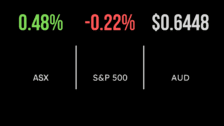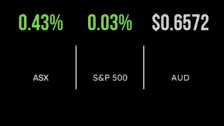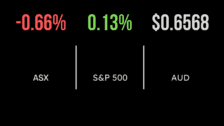Market takes backward step, Magellan’s struggles continue
A promising February on the Australian ran into a roadblock on Friday, with the benchmark S&P/ASX 200 Index surrendering 71.2 points on the day, or 1.0 per cent, to 7217.3 points.
While that was the biggest loss in more than two weeks, the index was still up 1.4% for the week, in its second straight rising week. Ten of 11 sector gauges eased lower on Friday, led by the tech stocks.
Afterpay’s purchaser Block (the CHESS Depositary Interests, or CDIs, that is, with which it paid APT shareholders) slipped 6.7% to $147.45, AI data services company Appen lost 6.3% to $8.42, and small-business accounting software leader Xero ended 4.5% lower.
Materials held up its end, with a 0.3% rise supported by higher Chinese steel and iron ore futures prices.
Rio Tinto rose by 2.9% to $122.36, Fortescue Metals Group gained 2.5% to $22.99, and BHP put on 1.2%, to $48.86.
The broader S&P/ASX All Ordinaries lost 79.7 points, or just over 1%, to 7,515.8, as the Australian market also felt the influence of US inflation concerns and geopolitical worries.
Funds leach at Magellan
Magellan Financial lost a further 94 cents, or almost 5%, to $18.11, as the company reported a funds under management update that showed that Magellan’s funds continue to leach money.
Investors – both institutional and retail – are voting with their feet over concerns at Magellan’s investment performance, and as ratings agencies review their recommendations, the market appears to believe the fund outflows will increase.
According to the release, at the close of the US market on 9 February, Magellan’s funds under management (FUM) stood at approximately $87.1 billion, down almost 9% in 2022 so far.
Chris Mackay, Magellan’s co-founder and interim lead global strategies portfolio manager, told investors the company will do “whatever it takes” to turn its underperformance streak around and manage the absence of co-founder Hamish Douglass.
Insurer IAG provided a highlight, adding 4.2% to $4.74 after upgrading its guidance for the key number gross written premium (the total amount of insurance premiums that the company sells to customers) would rise in the “mid-single-digits” for the year, after previously telling the market to expect “low single-digit” growth.
Baby goods retailer Baby Bunting had good news for the market, with net profit surging by 12.2% in the first half of the 2021-22 financial year, on the back of total sales rising by 10%, to $239.1 million. Same-store sales growth, including sales from online, was a more sedate 6.8%.
Perversely, Baby Bunting shares eased 16 cents, or almost 3%, to $5.27, to be down 5% year-to-date.
Ukraine rattles US markets, Fear Index pops
In the US, stocks fell sharply on Friday after the Biden Administration warned American citizens in Ukraine to leave “immediately” due to fears of an imminent invasion by Russia (other NATO nations followed suit).
Investors have enough worries already with inflation, interest rates and valuations, and the Russia/Ukraine concerns – particularly with respect to energy prices – could prove too much for market index levels to be maintained.
The S&P 500 index headed into the weekend down 85.4 points, or 1.9%, to 4,418.6 points, while the 30-stock Dow Jones Industrial Average lost 503.5 points, or 1.4%, to 34,738.1 points, and the tech-heavy Nasdaq was hardest-hit, down 394.5 points, or 2.8%, to 13,791.1 points.
West Texas Intermediate (WTI) crude oil jumped 3.6%, to US$93.10 a barrel, while Brent crude oil added 3.3%, to US$94.44 a barrel.
Last week, analysts at investment bank JP Morgan warned the market that crude prices could go as high as US$150 a barrel if there are disruptions caused by the conflict.
That was good news for the oil stocks such as Occidental Petroleum (up 5.7%) and Phillips 66 (up 4.2%); investors also never waste a crisis in terms of the defence heavyweights, with Northrop Grumman adding 4.5%, Lockheed Martin up 2.8%
The market’s increasing worry levels showed up in the VIX Index, which tracks the volatility expectations of the stock market on the basis of S&P 500 options; the so-called “Fear Index” surged 14.4% on Friday.











